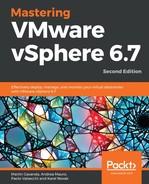Book Description
Unleash the benefits of VMware vSphere 6.7 to provide a powerful, flexible and secure digital infrastructure
Key Features
- Deep dive into areas like management, security, scalability, availability and more with vSphere 6.7
- Design, deploy and manage VMware vSphere virtual datacenters
- Implement monitoring and security of VMware workloads with ease
Book Description
VMware vSphere provides a powerful, flexible and secure foundation for next-generation applications and datacenters that help you with your digital transformation efficiently.
Mastering VMware vSphere, 6.7, Second Edition begins by covering an overview of all the products, solutions and features of the vSphere 6.7 suite, comparing the evolutions with the previous releases. You'll learn to design and plan a virtualization infrastructure to drive performance analysis and then proceed with the workflow and installation of components. Along with new network trends that will help you in optimally designing the vSphere environment, you will also learn the best practices involved in configuring and managing virtual machines in a vSphere infrastructure. With vSphere 6.7, you'll make use of more powerful capabilities for patching, upgrading and managing the configuration of the virtual environment. The concluding chapters focus on core vSphere components as storage and network and you will learn all you need about resource management followed by topics as high availability and disaster recovery, troubleshooting, monitoring and security.
By the end the book you will discover different approaches on how to build your own VMware vSphere lab to help you run even the most demanding workloads
What you will learn
- Get a deep understanding of vSphere 6.7 functionalities
- Design a virtualization environment based on VMware vSphere 6.7
- Manage and administer a vSphere 6.7 environment and resources
- Get tips for the VCP6-DCV and VCIX6-DCV exams
- Implement different migration techniques across different environments
- Deploy and understand different concepts of VMware vSphere 6.7 lab
Who this book is for
If you are an administrator, infrastructure engineer, IT architect, or an IT consultant who has basic knowledge of VMware vSphere and now wants to master it, then this book is for you.
